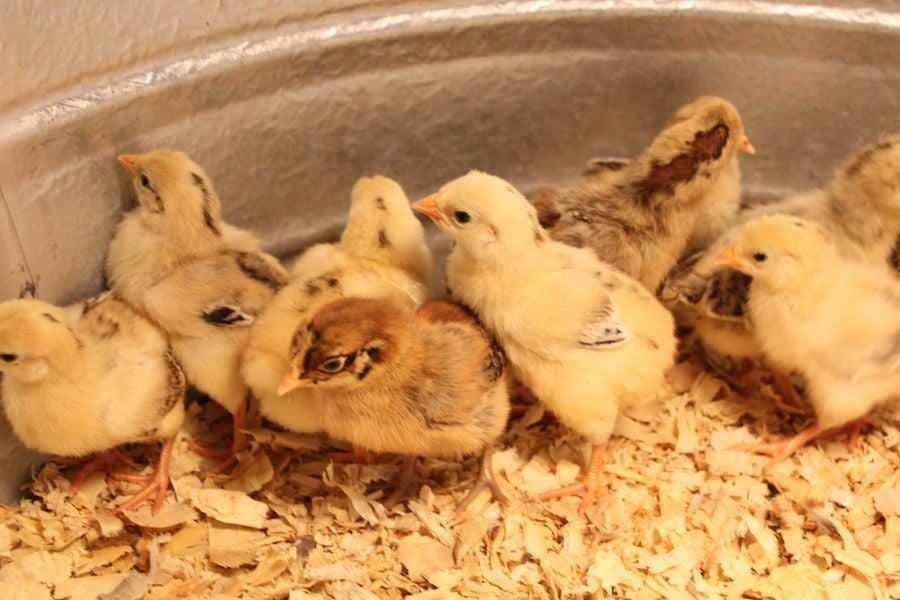- Jun 28, 2011
- 39,160
- 27,377
- 1,302
The Marsh Daisy breed was developed by a Mr Wright from Lancashire in the late 1800’s. The basis for the strain was the white Leghorn, of which hens were mated to a Black Hamburg male, which produced white rose combed birds. Later infusions of Game and Malay resulted in a strain of hardy and productive poultry. Mr Wright maintained these as a closed flock for thirty years. His stock came in three colours: Partridge, Wheaten and White.
In 1913 a Mr. Charles Moore bought two of the last of Mr Wright’s hens and crossed them to a Pit Game Cock. A male from this mating was then mated back to the original hens. Lastly a Sicilian Buttercup was used and this cross introduced green legs. Buffs, Wheatens and Whites were the original colours produced by Mr Moore, though Blacks and Browns were produced later.
Other poultry breeders started to breed Marsh Daisies and they were first exhibited in 1920. A Marsh Daisy Club was formed in 1921 at which time there were around 200 known flocks. The breed standard was recognised by the Poultry Club of Great Britain in 1922.
The original five colours of the Marsh Daisy, Black, Brown, Buff, Wheaten and White, are still recognised and it seems likely that the standard has never been updated. It has been suggested that the standardisation had been ‘rather premature’, for the Browns in particular.
The Marsh Daisy today is one of the UK's rarest chicken breeds, rescued from the brink of extinction, they are slowly regaining popularity, though their numbers are still low. With its distinctive rose comb and striking colouring, the Marsh Daisy is certainly a breed worth preserving. A very gentle breed, even the males showing little or no aggression. They are particularly happy in free range conditions, they do not mind rain and are good flyers. They lay reasonable numbers of tinted eggs, laying well into the winter months. The chicks are slow to mature, but make excellent table birds.
Details:
Origin: Great Britain
Purpose: Egg laying
Egg Laying: Good
Egg Colour: Tinted

Pic by DCchicken

Pic by DCchicken

Pic by @stoneunhenged

Pic by @stoneunhenged
BYC Breed Discussion:
https://www.backyardchickens.com/t/713991/marsh-daisy/0_30
Do you own Marsh Daisies? Are you a Marsh Daisy breeder? If so, please reply to this thread with the your thoughts and experiences, including:
· What made you decide to get this breed?
· Do you own them for fun? Breeding? Some other purpose?
· What are your favorite characteristics about this breed?
· Post some pics of your birds; male/female, chicks, eggs, etc!
We have a bunch of other awesome breed-focus threads for you to enjoy. You can see all of them here: https://www.backyardchickens.com/threads/chicken-breed-focus-project.975504/
In 1913 a Mr. Charles Moore bought two of the last of Mr Wright’s hens and crossed them to a Pit Game Cock. A male from this mating was then mated back to the original hens. Lastly a Sicilian Buttercup was used and this cross introduced green legs. Buffs, Wheatens and Whites were the original colours produced by Mr Moore, though Blacks and Browns were produced later.
Other poultry breeders started to breed Marsh Daisies and they were first exhibited in 1920. A Marsh Daisy Club was formed in 1921 at which time there were around 200 known flocks. The breed standard was recognised by the Poultry Club of Great Britain in 1922.
The original five colours of the Marsh Daisy, Black, Brown, Buff, Wheaten and White, are still recognised and it seems likely that the standard has never been updated. It has been suggested that the standardisation had been ‘rather premature’, for the Browns in particular.
The Marsh Daisy today is one of the UK's rarest chicken breeds, rescued from the brink of extinction, they are slowly regaining popularity, though their numbers are still low. With its distinctive rose comb and striking colouring, the Marsh Daisy is certainly a breed worth preserving. A very gentle breed, even the males showing little or no aggression. They are particularly happy in free range conditions, they do not mind rain and are good flyers. They lay reasonable numbers of tinted eggs, laying well into the winter months. The chicks are slow to mature, but make excellent table birds.
Details:
Origin: Great Britain
Purpose: Egg laying
Egg Laying: Good
Egg Colour: Tinted
Pic by DCchicken
Pic by DCchicken
Pic by @stoneunhenged
Pic by @stoneunhenged
BYC Breed Discussion:
https://www.backyardchickens.com/t/713991/marsh-daisy/0_30
Do you own Marsh Daisies? Are you a Marsh Daisy breeder? If so, please reply to this thread with the your thoughts and experiences, including:
· What made you decide to get this breed?
· Do you own them for fun? Breeding? Some other purpose?
· What are your favorite characteristics about this breed?
· Post some pics of your birds; male/female, chicks, eggs, etc!
We have a bunch of other awesome breed-focus threads for you to enjoy. You can see all of them here: https://www.backyardchickens.com/threads/chicken-breed-focus-project.975504/
Last edited by a moderator:





